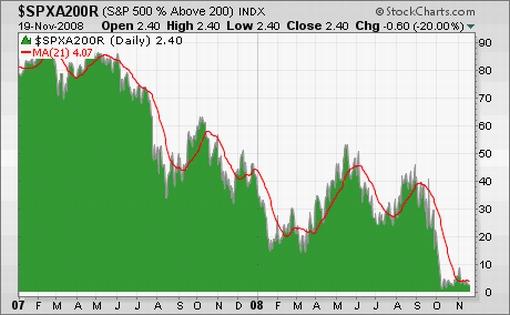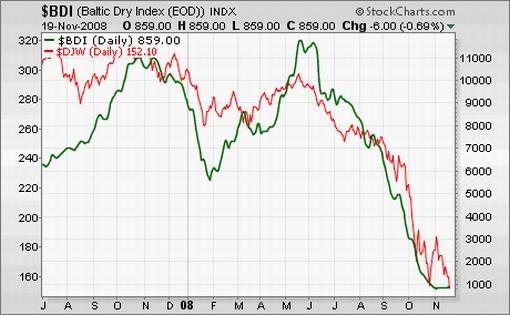Exploding Global Stock Markets Hit by Economic Torpedo
Stock-Markets / Financial Crash Nov 20, 2008 - 09:19 AM GMT Yesterday was another ugly day for stocks, with bourses around the globe falling victim to strong selling pressure. Fueling the sell-off were concerns that the economic recession could not only be deeper and longer than previously feared, but also fall into a corrosive deflationary phase.
Yesterday was another ugly day for stocks, with bourses around the globe falling victim to strong selling pressure. Fueling the sell-off were concerns that the economic recession could not only be deeper and longer than previously feared, but also fall into a corrosive deflationary phase.
The MSCI World Index and the MSCI Emerging Markets Index fell by 4.6% and 2.2% respectively, tallying declines of 51.2% and 63.4% since the peaks of these indices in October 2007. Only the Chinese Shanghai Composite Index (+6.0%) and the Russian Trading System Index (+0.7%) bucked yesterday's declines.
Click here or on the thumbnail below for a (very red) market map, obtained from Finviz , providing a quick overview of the performance of global stock markets (as reflected by the movements of ADR stocks).

As far as the US markets are concerned, the Dow Jones Industrial Index (-5.1%) plunged below the roundophobia 8,000 level, resulting in all the major indices now trading below the recent lows of October 10 and 27. This brings the lows of 2003 (Dow 7,524; S&P 500 801) and 2002 (Dow 7,286; S&P 500 777) into sight. A breach of these levels – frightfully close to the current levels of the Dow (7,997) and S&P 500 (807) – will wipe out the entire five-year bull market from 2002 to 2007.
Interestingly, only 2.4% of the 500 S&P 500 stocks now trade above their 200-day moving averages. This line is often used as a crude indicator of the primary trend of a market or individual stocks. The graph undeniably shows an extremely oversold situation, but bear markets have been known to stay oversold much longer than usual.

One can argue long and hard about valuation levels and earnings forecasts, but the extent to which stocks become undervalued in the grip of this bear is squarely in the hand of the severity of the economic meltdown. This is clearly shown by the relationship between the Dow Jones World Index and the Baltic Dry Index – an assessment of the price of moving the major raw materials, including coal, iron ore and grain, by sea and generally an excellent barometer of economic activity.

The worrisome prospects for economic and earnings growth, together with the threat of deflation, are spooking the financial markets. The extreme level of risk aversion is illustrated by the US three-month Treasury Bill rate falling to a minuscule 0.065% – a clear sign of distress and fear – and the yields on long-dated government bonds falling significantly in most parts of the world.
Here is what Richard Russell ( Dow Theory Letters ) – one of the few market commentators with first-hand experience of the Great Depression – has to say: “The market is warning of a coming depression. Next year there'll be a huge problem of unemployment, job openings will have disappeared, and every business will be going over its personal thinking in terms of who the business can do without.
“The sentiment in the country will be dark grey to jet black. Fortunes will have been wiped out. Thousands of savings plans and 401Ks will have been shattered. Americans who have never experienced true hard times will be living hard times. Confusion and fear will be rampant. How do I know all this? I've been here before, I know the signs.”
Oversold conditions have so far not produced more than a temporary reprieve, and nobody knows how far down this bear market will fall. Until we see more signs of base formations being developed, one should tread very cautiously. And remember the old Boy Scout adage: “Be prepared”.
Did you enjoy this post? If so, click here to subscribe to updates to Investment Postcards from Cape Town by e-mail.
By Dr Prieur du Plessis
Dr Prieur du Plessis is an investment professional with 25 years' experience in investment research and portfolio management.
More than 1200 of his articles on investment-related topics have been published in various regular newspaper, journal and Internet columns (including his blog, Investment Postcards from Cape Town : www.investmentpostcards.com ). He has also published a book, Financial Basics: Investment.
Prieur is chairman and principal shareholder of South African-based Plexus Asset Management , which he founded in 1995. The group conducts investment management, investment consulting, private equity and real estate activities in South Africa and other African countries.
Plexus is the South African partner of John Mauldin , Dallas-based author of the popular Thoughts from the Frontline newsletter, and also has an exclusive licensing agreement with California-based Research Affiliates for managing and distributing its enhanced Fundamental Index™ methodology in the Pan-African area.
Prieur is 53 years old and live with his wife, television producer and presenter Isabel Verwey, and two children in Cape Town , South Africa . His leisure activities include long-distance running, traveling, reading and motor-cycling.
Copyright © 2008 by Prieur du Plessis - All rights reserved.
Disclaimer: The above is a matter of opinion and is not intended as investment advice. Information and analysis above are derived from sources and utilizing methods believed reliable, but we cannot accept responsibility for any trading losses you may incur as a result of this analysis. Do your own due diligence.
Prieur du Plessis Archive |
© 2005-2022 http://www.MarketOracle.co.uk - The Market Oracle is a FREE Daily Financial Markets Analysis & Forecasting online publication.



